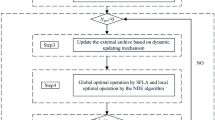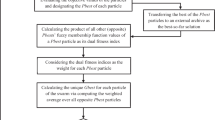Abstract
With the introduction of intelligent heuristic optimization strategies, there has been an increasing interest in the use of these methods for solving the design problem of water distribution networks (WDN). This paper proposes the use of a new version of heuristic shuffled frog leaping (SFL) algorithm for solving the problem of WDN design. First, in order to speed up the original SFL algorithm, an adaptive parameter is introduced. Then, momentum parts are added to the SFL to increase the ability of the algorithm in escaping from local optimums. Finally, a mutation operator is proposed to increase the diversification property of the algorithm. The new version of the SFL algorithm is called adaptive mutated momentum shuffled frog leaping (AMMSFL). The proposed AMMSFL is then applied to solve WDN design problems. An illustrative and comparative illustrative example is presented to show the efficiency and superiority of the introduced AMMSFL compared to the other well-known heuristic algorithms.

Similar content being viewed by others
Abbreviations
- WDN:
-
Water distribution network
- SFL:
-
Shuffled frog leaping
- AMMSFL:
-
Adaptive mutated momentum shuffled frog leaping
- GA:
-
Genetic algorithm
- PSO:
-
Particle swarm optimization
- ACO:
-
Ant colony optimization
- NLP:
-
Nonlinear programming
- NP:
-
Non-deterministic polynomial time
- HD-DDS:
-
Hybrid discrete dynamically dimensioned search
- EPANET:
-
Water distribution network simulator
- DE:
-
Differential evolution
- PSHS:
-
Particle swarm harmony search
- HS:
-
Harmony search
- GHEST:
-
Genetic heritage evolution by stochastic transmission
- SADE:
-
Self-adaptive differential evolution
- DLL:
-
Dynamic link library
- c i (D i ):
-
Cost per unit length of pipe diameter
- D i :
-
Pipe diameter
- δmax :
-
Upper bound of the inertia factor
- δmin :
-
Lower bound of the inertia factor
- L i :
-
Length of pipe i
- n pipe :
-
Total number of the network pipes
- Q jin :
-
Flow into of the node j
- Q jout :
-
Flow out of the node j
- Q j e :
-
Flow demand of the node j
- N :
-
Total number of the network nodes
- ΔH i :
-
Head loss in pipe i
- NL :
-
Total number of loops in the network
- ΔH i :
-
Head loss in pipe
- S :
-
Number of variables
- H u i and H d i :
-
Heads of both ends of pipe i
- ω:
-
Conversion constant
- C i :
-
Hazen–Williams loss coefficient
- α:
-
Regression coefficient
- β:
-
Regression coefficient
- P j :
-
Pressure head at node j
- P min j :
-
Minimum required pressure head at node j
- D :
-
Commercially available diameter list
- W p :
-
Penalty multiplier
- P :
-
Number of frogs in population
- X i :
-
Frog i
- m :
-
Number of memeplexes
- n :
-
Number of frogs
- p :
-
m × n
- X g :
-
Frog with the best cost function
- X b :
-
Frog with the best cost function
- X w :
-
Frog with the worst cost function
- D max :
-
Maximum allowed change in a frog’s position
- f(X b ):
-
The best cost function
- f(X w):
-
The worst cost function
- f(X g ):
-
The global best cost function
- ɛ :
-
A small constant
- δ :
-
Inertia factor
- γ :
-
Positive constant
- θ :
-
Positive constant
- θ:
-
Positive constant
- \({\Delta X_W^{i-1}}\) :
-
\({=X_W^{i-1} -X_W^{i-2}}\)
- \({\Delta X_W^{i-2}}\) :
-
\({=X_W^{i-3} -X_W^{i-4}}\)
- X k W :
-
Value of X w in kth iteration
- i :
-
Number of iteration
- i max :
-
Maximum number of iterations
- S rate %:
-
Percentage of superseding frogs
References
Yates, D.F.; Templeman, A.B.; Boffey, T.B.: The computational complexity of the problem of determining least capital cost designs for water supply networks. Eng. Optim. 7, 143–145 (1984)
Schaake, J.C; Lai, D.: Linear programming and dynamic programming applied to water distribution network design. MIT Hydrodynamics Lab Report 116; 1969.
Alperovits, E.; Shamir, U.: Design of optimal water distribution systems. Water Resour. Res. 13(6), 885–900 (1977)
Varma, K.; Narasimhan, S.; Bhallamudi, S.M.: Optimal design of water distribution systems using NLP method. J. Environ. Eng. 123, 381–388 (1997)
Sherali, H.D.; Totlani, R.; Loganathan, G.V.: Enhanced lower bounds for the global optimization of water distribution networks. Water Resour. Res. 34, 1831–1841 (1998)
Prasad, D.T.; Park, N.S.: Multiobjective genetic algorithms for design of water distribution networks. J. Water Resour. Plan. Manag. 130, 73–82 (2004)
Kadu, M.S.; Gupta, R.; Bhave, P.R.: Optimal design of water networks using a modified genetic algorithm with reduction in search space. J. Water Resour. Plan. Manag. 134, 147–160 (2008)
Bolognesi, A.; Bragalli, C.; Marchi, A.; Artina, S.: Genetic heritage evolution by stochastic transmission in the optimal design of water distribution networks. Adv. Eng. Softw. 41, 792–801 (2010)
Banos, R.; Gil, C.; Reca, J.; Montoya, F.G.: A memetic algorithm applied to the design of water distribution networks. Appl. Softw. Comput. 10, 261–266 (2010)
Eusuff, M.M.; Lansey, K.E.: Optimization of water distribution network design using the shuffled frog leaping algorithm. J. Water Resour. Plan. Manag. 129, 210–225 (2003)
Tospornsampan, J.; Kita, I.; Ishii, M.; Kitamura, Y.: Split-pipe design of water distribution network using simulated annealing. Int. J. Comput. Inform. Syst. Sci. Eng. 1, 153–163 (2007)
Zecchin, A.C.; Maier, H.R.; Simpson, A.R.; Leonard, M.; Nixon, J.B.: Ant colony optimization applied to water distribution system design: comparative study of five algorithms. J. Water Resour. Plan. Manag. 133, 87–92 (2007)
Geem, Z.W.: Optimal cost design of water distribution networks using harmony search. Eng. Optim. 38, 259–280 (2006)
Sung, Y.H.; Lin, M.D.; Lin, Y.H.; Liu, Y.L.: Tabu search solution of water distribution network optimization. J. Environ. Eng. Manag. 17, 177–187 (2007)
Montalvo, I.; Izquierdo, J.; Perez, R.; Tung, M.M.: Particle swarm optimization applied to the design of water supply systems. Comput. Math. Appl. 56, 769–776 (2008)
Geem, Z.W.: Particle-swarm harmony search for water networks design. Eng. Optim. 41, 297–311 (2009)
Montalvo, I.; Izquierdo, J.; Perez, R.; Herrera, M.: Improved performance of PSO with self-adaptive parameters for computing the optimal design of water supply systems. Eng. Appl. Artif. Intell. 23, 727–735 (2010)
Aghdam, K.M.; Mirzaee, I.; Pourmahmood, N.; Aghababa, M.P.: Design of water distribution networks using accelerated momentum particle swarm optimisation technique. J. Exp. Theoret. Artif. Intell. (2014). doi:10.1080/0952813X.2013.863227
Chu, C.W.; Lin, M.D.; Liu, G.F.; Sung, Y.H.: Application of immune algorithms on solving minimum-cost problem of water distribution network. Math. Comput. Model. 48, 1888–1900 (2008)
Dong, X.L.; Liu, S.-Q.; Tao, T.; Li, S.P.; Xin, K.L.: A comparative study of differential evolution and genetic algorithms for optimizing the design of water distribution systems. J. Zhejiang Univ. Sci. A (Appl. Phys. Eng.) 13, 674–686 (2012)
Zheng, F.; Simpson, A.R.; Zecchin, A.C.: A combined NLP-differential evolution algorithm approach for the optimization of looped water distribution systems. Water Resour. Res. 47, W08531 (2011)
Zheng, F.; Zecchin, A.C.; Simpson, A.R.: A self-adaptive differential evolution algorithm applied to water distribution system optimization. J. Comput. Civ. Eng. ASCE 27, 148–158 (2013)
Tolson, B.A.; Asadzadeh, M.; Maier, H.R.; Zecchin, A.C.: Hybrid discrete dynamically dimensioned search (HD-DDS) algorithm for water distribution system design optimization. Water Resour. Res. 45, W12416 (2009)
Zecchin, A.C.; Simpson, A.R.; Maier, H.R.; Nixon, J.B.: Parametric study for an ant algorithm applied to water distribution system optimization. IEEE Trans. Evol. Comput. 9, 175–191 (2005)
Mohan, S.; Jinesh Babu, K.S.: Optimal water distribution network design with Honey-Bee mating optimization. J. Comput. Civ. Eng. 24, 117–126 (2010)
Adarsh, S.; Sahana, A.S.: Minimum cost design of irrigation canals using probabilistic global search lausanne. Arab. J. Sci. Eng. 38, 2631–2637 (2013)
Al-Qutub, A.; Taleb, J.; Mokheimer, E.M.A.: A novel approach for optimizing two-phase flow in water rockets: Part I. Arab. J. Sci. Eng. (2013). doi:10.1007/s13369-013-0779-7
Vatani, A.; Mehrpooya, M.; Pakravesh, H.: Modification of an industrial ethane recovery plant using mixed integer optimization and shuffled frog leaping algorithm. Arab. J. Sci. Eng. 38, 439–455 (2013)
Vijaychakaravarthy, G.; Marimuthu, S.; Naveen Sait, A.: Comparison of Improved sheep flock heredity algorithm and artificial bee colony algorithm for lot streaming in m-machine flow shop scheduling. Arab. J. Sci. Eng. (2014). doi:10.1007/s13369-014-0994-x
Rossman, L.A.: EPANET 2 users manual. Reports EPA/600/R-00/057. US Environ. Prot. Agency, Cincinnati, Ohio (2000)
Liong, S.Y.; Atiquzzaman, M.D.: Optimal design of water distribution network using shuffled complex evolution. J Inst Eng 44, 93–107 (2004)
EPANET Programmer’s Toolkit, Water Supply and Water Resources Division of the U.S. Environmental Protection Agency’s National Risk Management Research Laboratory
Fujiwara, O.; Khang, D.B.: A two phase decomposition method for optimal design of looped water distribution networks. Water. Resour. Res. 26, 539–549 (1990)
Dandy, G.C.; Simpson, A.R.; Murphy, L.J.: An improved genetic algorithm for pipe network optimization. Water Resour. Res. 32, 449–458 (1996)
Maier, H.R.; Simpsom, A.R.; Zwcchin, A.C.; Foong, W.K.; Phang, K.Y.; Seah, H.Y.; Tan, C.L.: Ant colony optimization for the design of water distribution systems. J. Water. Resour. Plan. Manag. 129, 200–209 (2003)
Author information
Authors and Affiliations
Corresponding author
Rights and permissions
About this article
Cite this article
Aghdam, K.M., Mirzaee, I., Pourmahmood, N. et al. Adaptive Mutated Momentum Shuffled Frog Leaping Algorithm for Design of Water Distribution Networks. Arab J Sci Eng 39, 7717–7727 (2014). https://doi.org/10.1007/s13369-014-1367-1
Received:
Accepted:
Published:
Issue Date:
DOI: https://doi.org/10.1007/s13369-014-1367-1




